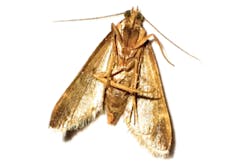Contaminant of the Month: Chlorate
What it is:
• Chlorate is an anion that can enter drinking water from several potential sources, including from hypochlorite or chlorine dioxide disinfectant use, ozone oxidation of hypochlorite or chlorite and source water contamination from pesticide runoff or papermill discharges.
• Chlorate is used in explosives and also as a pesticide.
• Hypochlorite and chlorine dioxide use as disinfectants are by far the principal sources in drinking water.
Occurrence:
• The byproducts chloride (Cl–), chlorite (ClO2–) and chlorate (ClO3–) are formed when chlorine dioxide is used to disinfect water and to oxidize some taste and odor components. About 70 percent of the applied chlorine dioxide is eventually converted to chlorite and about 10 percent to chlorate.
• Chlorine in some form (gaseous, hypochlorite or chloramine) is used on almost 90 percent of drinking water supplies. Hypochlorite is used by more than 20 percent of water supplies, but the numbers are growing because many supplies have shifted to hypochlorite from free chlorine because of security and handling risks of chlorine gas.
• Chlorate is spontaneously generated in hypochlorite solutions by what are called disproportionation reactions of hypochlorite (hypochlorite reacting with itself), and the amount continues to increase during storage, potentially reaching several thousand ppm. The rate of conversion is a function of hypochlorite concentration, storage temperature, time and pH.
• Perchlorate forms in stored hypochlorite solutions as a secondary reaction after chlorate generation.
• Chlorine dioxide is used in drinking water to some degree in more than 6 percent of water supplies in the U.S.
• If ozone is applied to water treated with chlorine or chlorine dioxide that has not been dechlorinated, oxidation to chlorate will occur.
• Chlorate has been included in several national monitoring studies including the 1997-1998 EPA Information Collection Rule (ICR) that produced data from 353 surface water systems. It has also been included in the 3rd U.S. EPA Unregulated Contaminant Monitoring Rule (UCMR).
• In the ICR, 14 percent of samples and 37 percent of plants of hypochlorite users exceeded 210 ug/L; 23 percent of samples and 52 percent of plants of chlorine dioxide users exceeded 210 ug/L. Two-hundred and ten ug/L was the health reference level (HRL) that EPA calculated by arbitrarily using a 20 percent relative source contribution (RSC) from drinking water. However, the HRL would have been 840 ug/L if the more appropriate 80 percent relative source contribution value had been used.
Health effects:
• Chlorate competes with iodide for transport to the thyroid, although it does not bind as strongly as perchlorate, and it can be metabolized, whereas perchlorate is very stable after ingestion. Consumption by infants and young children in high concentrations can cause problems to the nervous system and anemia based upon studies at high test doses in animals. The same effects could occur in the fetus of a pregnant woman at sufficiently high doses.
• The chemistry of chlorate indicates that upon ingestion of small quantities from water in the acidic stomach, it would be reduced by reactions reducing agents like sulfide, nitrite and iodide that are naturally present. These reductive processes are probably slower than they occur with bromate.
Environmental effects:
• Chlorate does not survive for long periods in the environment. It is readily biodegraded by microorganisms under anerobic conditions, and there is no indication of bioaccumulation.
Water treatment:
• Removal by anion exchange is expensive. Control would focus on hypochlorite management to reduce excess formation during storage. Hypochlorite should be used as soon as practicable, and not be stored for excessive time, and it should be stored out of sunlight to keep the hypochlorite solution as cool as possible. The pH should be maintained at 12. The typical concentration of purchased hypochlorite is about 12 percent; the rate of production of chlorate can also be reduced by dilution upon receipt.
• Chlorine dioxide is produced on site and not stored. The production conditions should be managed to avoid any carryover. Dosage should not be excessive to prevent excessive formation of chlorate when chlorine dioxide is used in water treatment.
Regulation:
• There is no current maximum contaminant level (MCL) for chlorate. There is a Canadian Guideline of 1 mg/L that assumes a relative source contribution (RSC) from drinking water of 80 percent and includes a safety (uncertainty) factor of 1,000 in the calculation from animal toxicology data. California has no MCL but a notification level of 800 ug/L (0.80 mg/L).
• The World Health Organization (WHO) guideline for chlorate is 0.7 mg/L.
Sources: World Health Organization, Environmental Protection Agency.
References: Chen and Regli, Information Collection Rule Data Analysis, 2002. Guidelines for Canadian Drinking Water Quality, 2009. Volk et al, J.Env.Eng.Sci., 2002. McCauley, et al, Drug and Chemical Toxicology, 1995.
Dr. Joseph Cotruvo is president of Joseph Cotruvo and Associates, LLC, Water, Environment and Public Health Consultants. He is a former director of the U.S. EPA Drinking Water Standards Division.
